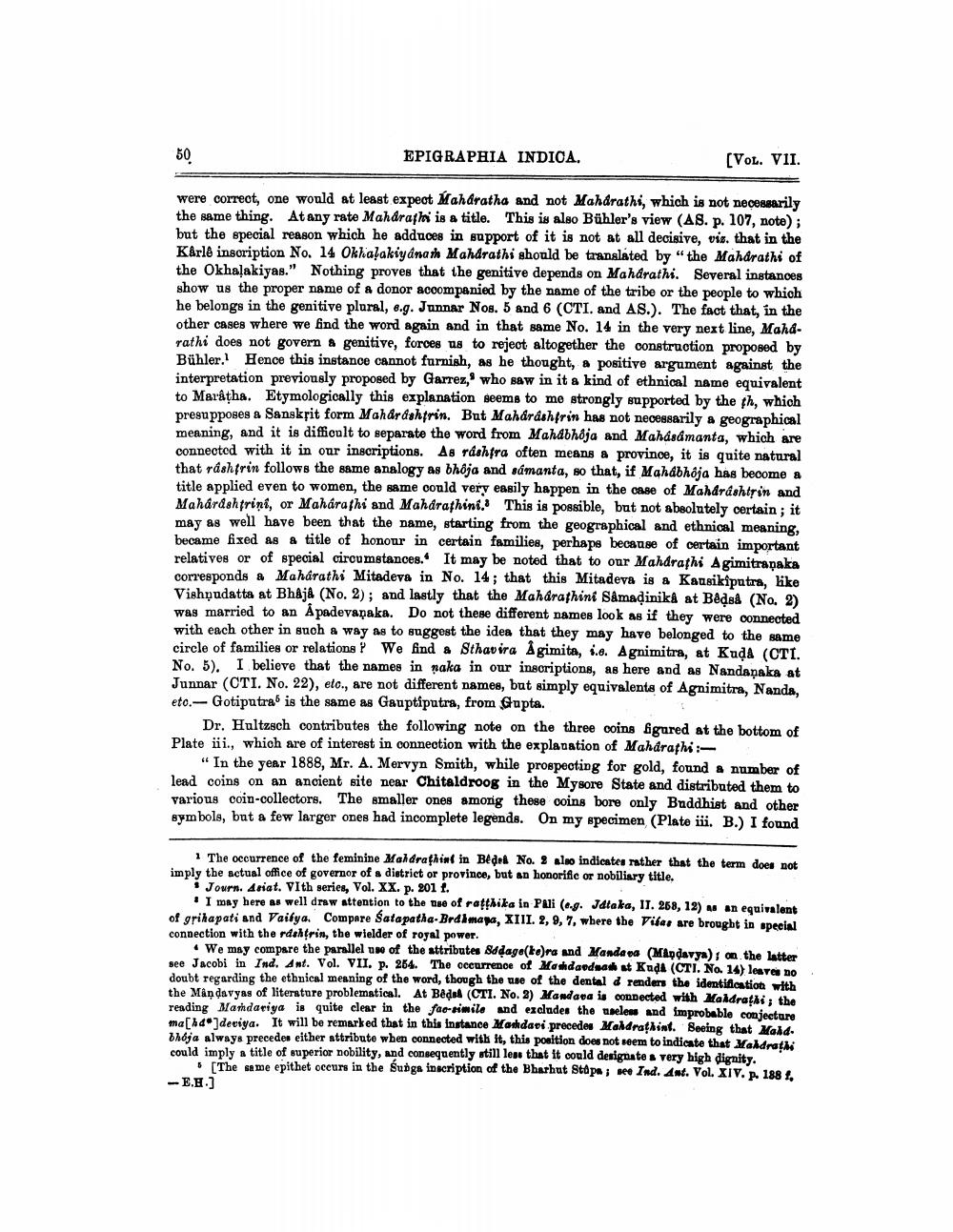________________
EPIGRAPHIA INDICA.
(VOL. VII.
were correct, one would at least expect Maharatha and not Mahdrathi, which is not necessarily the same thing. At any rate Maharafli is a title. This is also Bühler's view (AS. p. 107, note); but the special reason which he adduces in support of it is not at all decisive, vis. that in the Kärle inscription No. 14 Okkalakiyanah Mahdrathi should be translated by " the Maharathi of the Okhalakiyan." Nothing proves that the genitive depends on Maharathi. Several instances show us the proper name of a donor accompanied by the name of the tribe or the people to which he belongs in the genitive plural, e.g. Junnar Nos. 5 and 6 (CTI. and AS.). The fact that, in the other cases where we find the word again and in that same No. 14 in the very next line, Mahdrathi does not govern & genitive, forces us to rejeot altogether the construction proposed by Bühler. Hence this instance cannot furnish, as he thought, a positive argument against the interpretation previously proposed by Garrez, who saw in it a kind of ethnical name equivalent to Maratha. Etymologically this explanation seems to me strongly supported by the th, which presupposes a Sanskrit form Maharashtrin. But Maharashtrin has not necessarily a geographical meaning, and it is difficult to separate the word from Mahabhôja and Mahasamanta, which are connected with it in our inscriptions. As rashtra often means a province, it is quite natural that räshfrin follows the same analogy as bhoja and samanta, so that, if Mahabhôja has become a title applied even to women, the same could very easily happen in the case of Maharashtsin and Maharashtrini, or Maharathi and Mahdrathini. This is possible, but not absolutely certain ; it may as well have been that the name, starting from the geographical and ethnical meaning, became fixed as a title of honour in certain families, perhaps because of certain important relatives or of special circumstances. It may be noted that to our Maharathi Agimitranaka corresponds a Maharathi Mitadeva in No. 14; that this Mitadeva is & Kausikiputra, like Vishnudatta at Bhaja (No. 2); and lastly that the Maharathini Samadinikå at Badea (No. 2) was married to an A padevanaka. Do not these different names look as if they were connected with each other in such a way as to suggest the idea that they may have belonged to the same circle of families or relations? We find a Sthavira A gimita, s.e. Agnimitra, at Kuda (CTI. No. 5). I believe that the names in raka in our inscriptions, as here and as Nandanaka at Junnar (CTI. No. 22), etc., are not different names, but simply equivalents of Agnimitra, Nanda, eto.-- Gotiputra is the same as Gauptiputra, from Gupta
Dr. Hultzsch contributes the following note on the three coins figured at the bottom of Plate iii., which are of interest in connection with the explanation of Maharathi :
"In the year 1888, Mr. A. Mervyn Smith, while prospecting for gold, found a number of lead coins on an ancient site near Chitaldroog in the Mysore State and distributed them to various coin-collectors. The smaller ones amorig these coins bore only Buddhist and other symbols, but a few larger ones had incomplete legends. On my specimen (Plate iii. B.) I found
1 The occurrence of the feminine Maldrathin in Bedel No. 9 Bloo indicates rather that the term does not imply the actual office of governor of a district or province, but an honorific or nobiliary title,
Journ. Asiat. Vith series, Vol. XX. p. 201 .
"I may here as well draw attention to the use of ratthika in Pili (e.g. Jdlaka, 11. 268, 12) m an equivalent of grihapati and Vailya. Compare Satapatha.Brdhmapa, XIII. 2, 9, 7, where the Vilar are brought in special connection with the rdshfrin, the wielder of royal power.
We may compare the parallel use of the attributes 8ddage(ke)ra and Mandard (Mandavyo) i on the latter see Jacobi in Ind. Ant. Vol. VII. p. 264. The occurrence of Mandardaad st Kodi (CTI. No. 14) leave no doubt regarding the ethnical meaning of the word, though the use of the dental & renders the identification with the Mandavas of literature problematical. At Beds (CTI. No. 3) Mandaca is connected with Madrati, the reading Mathdariya is quite clear in the fac-simile and excludes the useless and improbable conjecture maladeviya. It will be remarked that in this instance Mardani precedes Maldrafhint. Beeing that Mald. indja always preceden either attributo when connected with it, this pooltion does not seem to indicate that Maldratki could imply a title of superior nobility, and consequently still less that it could designates very high dignity.
The same epithet occurs in the Sudga inscription of the Bharhut Stopa; see Ind. Ant. Vol. XIV. p. 188 f. -E.H.]




